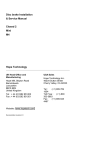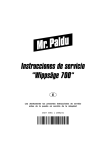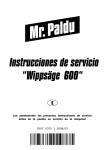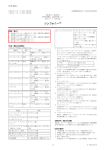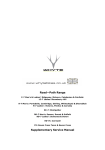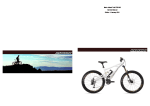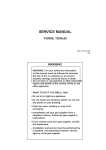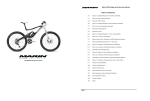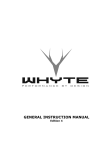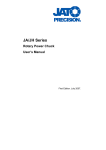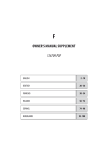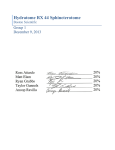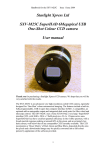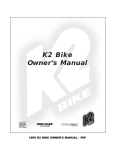Download 2016 Whyte MTB Full Suspension Supplementary Service Manual
Transcript
MTB Full Suspension Range G-160 Works & G-160 RS T-130-C Works & T-130-C RS T-130 RS, T-130 S & T-130 SX Women’s Spec T-129 SCR, T-129 RS & T-129 S Supplementary Service Manual 2016 Edition 1 Table of Contents 1.0 Introduction 2.0 Geometry: 2.1 G-160 Works & G-160 RS 2.2 T-130-C Works & T-130-C RS. T-130 RS, T-130 S & T-130 SX Women’s Spec 2.3 T-129 SCR, T-129 RS & T-129 S 3.0 Preparations for riding: 3.1 Making Adjustments 3.2 Whyte Inter Grip Seat Clamp Adjustment 3.3 Set up of Fork 3.4 Set up of Rear Damper 3.5 Suspension Tuning Log 4.0 Safety. 5.0 Lubrication: 5.1 Whyte Inter Grip Seat Clamp 5.2 General Lubrication 6.0 Servicing the Rear Suspension: 6.1 Removing the Rear Shock and Swinging Arm 6.1.1 From G-160 6.1.1.1 Remove the Rear Shock only. 6.1.1.2 Remove the other rear suspension parts. 6.1.2 From T-130-C, T-130 or T-129 6.1.2.1 Remove the Rear Shock only. 6.1.2.2 Remove the other rear suspension parts. 6.2 Stripping and Re-assembling Rear Suspension Bearings 6.2.1 Extraction of Bearings 6.2.2 Insertion of Bearings 6.2.3 Re-Assembly of Shield Washers / Spacers 6.3 Re-assembling the Rear Suspension 6.3.1 Re-Assembly of the Rear Suspension (G-160) 6.3.1.1 Re-assemble the other rear suspension parts. 6.3.1.2 Re-assemble the Rear Shock into the Frameset. 6.3.2 Re-Assembly of Rear Suspension (T-130-C, T-130 or T129) 6.3.2.1 Re-assemble the other rear suspension parts. 6.3.2.2 Re-assemble the Rear Shock into the Frameset. 2016 Edition 1 Page 3 WHYTE Service Manual Table of Contents (continued) 7.0 Servicing the Whyte Modular Dropout Systems: 7.1 Disassembly of Modular Rear Dropouts 7.1.1 Shimano E-Thru 7.1.2 SRAM Maxle 142mm 7.2 Reassembly of Modular Rear Dropouts 7.2.1 Shimano E-Thru 7.2.2 SRAM Maxle 142mm 7.3 Rear Derailleur Set-up 8.0 Servicing the Whyte Inter Grip Seat Clamp 9.0 Fitting Internal Cables & Hoses. 9.1 To replace cable or hose outers. 9.2 To fit a “Dropper” seat-post with internal hose. 10.0 Torque Settings. 11.0 Owner’s Notes 1.0: INTRODUCTION Thanks for choosing to purchase this Whyte product. We hope you will enjoy all the benefits its advanced design and engineering will bring to your riding experience. This manual will guide you through the set-up, safety and maintenance procedures that are specific to your Whyte bike. For other more general information, we strongly advise that you also read thoroughly the General Instruction Manual that is also supplied with your new bike. Also, please note that the specification of all the components that are fitted to your bike as standard may be obtained from the Whyte Bikes Brochure or alternatively from the Whyte Bikes website www.whytebikes.co.uk Please remember, if you are in any doubt about your ability to safely service or repair your Whyte bike, do not ride it and instead arrange for a professional bicycle mechanic at your local Whyte dealer to do the job correctly. Bundled with this manual, are the respective manufacturers instructions and manuals for the branded parts that are fitted to your Whyte bike. Please take time to study all the relevant instruction manuals to ensure you have a continually safe and well set-up bike before every ride, and to help you build up a relationship of knowledge between you and your Whyte Dealer. Happy and safe riding, Whyte design team. May 2015. Page 4 2016 Edition 1 WHYTE Service Manual 2.0: GEOMETRY Figure1: Geometry 2016 Edition 1 Page 5 WHYTE Service Manual 2.1: Whyte G-160 Geometry Frame Size X Small Medium Large Head Angle A 65.5° 65.5° 65.5° Seat Angle* B 74.7° 74.5° 74.3° Top Tube C 607.6mm 636.6mm 655.9mm BB Height** D 342.5mm 342.5mm 342.5mm Stand Over E 808mm 816mm 822mm Wheel Base F 1181.7mm 1211.7mm 1231.7mm Chain Stay G 425mm 425mm 425mm Seat Post H 30.9mm 30.9mm 30.9mm Notes: Geometry shown here is ’Showroom’ i.e. without rider aboard the bicycle. ’With Sag’ geometry is with rider after correct sag is set at front and rear. Please refer to suspension set up for information on how to achieve the correct sag of the fork and rear damper. * Effective seat angle, from wheel centres horizontal to line from BB to seat post axis @ top of saddle. ** BB height with Ø717mm tyres fitted (2.25” / 54-584) 2.2: Whyte T-130-C & T-130 Geometry Frame Size X Extra Small Small Medium Large Extra-Large Head Angle A 66.5° 66.5° 66.5° 66.5° 66.5° Seat Angle* B 74.0° 73.7° 73.5° 73.3° 73.2° Top Tube C 571.7mm 591.4mm 611.1mm 631.0mm 650.7mm BB Height** D 331.0mm 331.0mm 331.0mm 331.0mm 331.0mm Stand Over E 761mm 763mm 766mm 776mm 776mm Wheel Base F 1118.5mm 1136.5mm 1156.5mm 1176.5mm 1196.5mm Chain Stay G 420mm 420mm 420mm 420mm 420mm Seat Post H 30.9mm 30.9mm 30.9mm 30.9mm 30.9mm Notes: Geometry shown here is ’Showroom’ i.e. without rider aboard the bicycle. ’With Sag’ geometry is with rider after correct sag is set at front and rear. Please refer to suspension set up for information on how to achieve the correct sag of the fork and rear damper. * Effective seat angle, from wheel centres horizontal to line from BB to seat post axis @ top of saddle. ** BB height with Ø717mm tyres fitted (2.25” / 54-584) Page 6 2016 Edition 1 WHYTE Service Manual 2.3: Whyte T-129 Geometry Frame Size X Small Medium Large Extra—Large Head Angle A 66.5° 66.5° 66.5° 66.5° Seat Angle* B 74.2° 74.0° 73.8° 73.6° Top Tube C 593.4mm 613.4mm 633.1mm 652.8mm BB Height** D 335mm 335mm 335mm 335mm Stand Over E 800mm 805mm 810mm 815mm Wheel Base F 1156.1mm 1176.1mm 1196.1mm 1216.1mm Chain Stay G 431mm 431mm 431mm 431mm Seat Post H 30.9mm 30.9mm 30.9mm 30.9mm Notes: Geometry shown here is ’Showroom’ i.e. without rider aboard the bicycle. ’With Sag’ geometry is with rider after correct sag is set at front and rear. Please refer to suspension set up for information on how to achieve the correct sag of the fork and rear damper. * Effective seat angle, from wheel centres horizontal to line from BB to seat post axis @ top of saddle. ** BB height with Ø748mm tyres fitted (29” x 2.25” / 54/56-622) 2016 Edition 1 Page 7 WHYTE Service Manual 3.0: PREPARATIONS FOR RIDING 3.1: MAKING ADJUSTMENTS Please refer to the specific component manufacturers manual or published technical information about adjusting the components on your Whyte bike. Instructions may be downloaded from the relevant manufacturer’s internet site, as shown in the table to the right. CAUTION! If you are uncertain in any way, about making adjustments to any components on you Whyte bike, then DO NOT RIDE YOUR BIKE. Contact your Whyte dealer who will be able to advise you on how to go about setting up you Whyte bike for riding, and or making adjustments to the components fitted to your Whyte bike. DT Swiss www.dtswiss.com Easton www.eastonbike.com Formula www.formulahubs.com Fox www.foxracingshox.com Hope www.hopetech.com Jagwire www.jagwireusa.com Maxxis www.maxxis.com Race Face www.raceface.com Shimano www.shimano.com SR Suntour www.srsuntour-cycling.com SRAM www.sram.com Tektro www.tektro.com WTB www.wtb.com 3.2: WHYTE INTER GRIP SEAT CLAMP ADJUSTMENT & SERVICE Tools Required: 5mm AF Allen Keys (2 off, 1 fitted to a 3Nm to 15Nm Torque Wrench) Small Size Flat Blade Screwdriver SKF LGEP2 or Castrol Spheerol AP3 or Finish Line Teflon White Lithium Complex grease Reference figures 2 to 7. The Inter Grip seat clamp design is present on most models of Whyte full suspension mountain bikes. It allows adjustment of the saddle height & direction. CAUTION! Avoid over-tightening the seat clamp. In particular, “dropper” seat-posts such as SRAM Reverb may not work correctly if the seat clamp is over tightened. Figure 2. To adjust the seat height and/or direction, using the 5mm Allen key, undo the M6 Capscrew (1) just enough to allow the Seat Post (7) to slide freely up and down. Set the height and/or direction to the desired level. Figure 3. Re-tighten the M6 Capscrew (1) with the 5mm Allen Key in the Torque Wrench to the 6Nm limit, as marked on the Plain Sleeve (2). Figures 4 & 5. If a “dropper” seat-post is fitted, simultaneously depress the activation trigger Page 8 2016 Edition 1 WHYTE Service Manual and press down on the saddle to compress the seat-post until it is fully down. Then release the activation trigger and the seat-post should rise up automatically. Figure 6. If this does not happen, gradually loosen the M6 Capscrew (1) with the 5mm Allen Key below the 6Nm limit, until the seat-post rises automatically. Figure 7. Then firmly twist the saddle to confirm the seat-post is still securely gripped by the lowered torque value that allows the “dropper” seat-post to function correctly. CAUTION! When adjusting the saddle height you MUST obey the Minimum insertion depth requirement marked on the Seat Post (7). Also consult the seat-pin manufacturers instructions in conjunction with these notes. Figure 2 Figure 3 Figure 4 Figure 5 Figure 6 Figure 7 2016 Edition 1 Page 9 WHYTE Service Manual 3.3: SET UP OF FORK Tools Required: Good Quality Shock Pump. Small Ruler The front suspension fork fitted to your Whyte bike will be pre-set with the standard settings. Before riding, you may need to adjust these setting. First is the Sag setting on the fork. This is to ensure the forks are set-up correctly for your own body weight, so the fork will perform as intended. To set Sag on the front fork, you need to measure the amount the fork compresses when you sit on the bike in the normal riding position. See the table on the right for our recommendation of front fork sag on your Whyte bike. To achieve this you will need to adjust the air spring pressure inside the fork. Refer to the specification tables in this manual, and then to the relevant fork manufacturers set up instructions to find how to adjust the air spring pressure in the fork. Using a shock pump, either add or remove air until Sag is correctly set. Model Sag (15% Firm) Sag (25% Plush) T-129 18mm 30mm T-130 19.5mm 32.5mm G-160 24mm 40mm Please note that for the detailed instructions for servicing and all matters relating to the forks fitted to your Whyte bike, please refer to the manufacturers instructions. Rebound Damping adjustment: This adjustment fine-tunes the speed at which the wheel returns to its normal ride height after hitting a bump. Refer to the relevant manufacturers instructions to find out how to adjust the rebound damping. To demonstrate the effect of this function, turn the adjuster to its slowest setting. Press down on the handlebars to compress the forks, then release the load. The suspension recovers very slowly to its original position. Repeat the above with the adjuster turned to the fastest setting and the difference will be seen immediately the load is released. We recommend the optimum setting is to adjust the re-bound damping to be as slow as possible, but not so slow that the normal ride height is not recovered. On very rough terrain, if the bike becomes progressively lower as more bumps are hit then the re-bound damping is set too slow. On the other hand if the bike feels choppy and not plush then the re-bound damping is too fast. A bit of trial and error is needed to get the exact setting. IMPORTANT SAFETY NOTE: Always stop riding when making adjustments of any kind to the bicycle! Page 10 2016 Edition 1 WHYTE Service Manual 3.4: SET UP OF REAR DAMPER Tools Required: Good Quality Shock Pump. Small Ruler Your Whyte bike is fitted with and air spring rear shock absorber. This means that the air pressure in the shock absorber determines the spring rate. The correct ‘sag’ can be found using the sliding ‘O’ ring fitted to the shaft of the shock piston. Slide the ‘O’ ring against the shock body. Then gently sit on the bike in your normal riding position and with normal riding gear, including back pack if applicable, and also raise your feet off the floor. Carefully dismount and measure the distance the Model Sag ‘O’ ring has moved away from the shock body. T-129 17mm (25%) The optimum distance for the Quad-Link rear suspension system T-130 17mm (25%) is shown in the table to the right. If there is less than that distance fit a shock pump and release air pressure. Conversely if G-160 19mm (30%) there is greater than that distance, fit the shock pump and increase air pressure. Repeat the ‘sag’ test until the recommended sag distance is achieved. Rear Suspension Set-up - Rebound Damping: When the damper unit is being compressed, this is known as the compression stroke. As the suspension unit recovers from compression back towards its full length, this is called the re-bound stroke. All the shocks fitted as standard to the Whyte full suspension mountain bikes have factory set compression damping, and manually adjustable rebound damping. Rebound Damping Adjustment: The advice in section 3.3 about the fork rebound damping adjustments also applies to the rear shock. IMPORTANT SAFETY NOTE: Always stop riding when making adjustments of any kind to the bicycle! Platform Damping Adjustment. The rear Shock fitted to your Whyte bike may have a “platform” facility to adjust the slow speed compression damping, eg Fox “C.T.D.” (Climb / Trail / Descend) or SRAM RockShox “Motion Control”. Please refer to the relevant shock manufactures technical information to learn how to adjust these features. Please note, that the Whyte rear suspension systems have been designed not to rely on excessive low speed compression damping to obtain efficient pedalling performance, and turning on too much low speed damping on the rear shock will compromise the suspensions sensitivity to small bump absorption and traction. 2016 Edition 1 Page 11 WHYTE Service Manual 3.5: SUSPENSION TUNING LOG Record your best suspension settings in the table below, to restore them if necessary, eg. after dealer servicing of the suspension or if a friend has borrowed your bike. Date Rider Weight (including all riding kit) (kg or lbs) Fork Pressure (bar or P.S.I) Fork Rebound Damping (# of clicks from softest setting) Shock Pressure (bar or P.S.I) Shock Rebound Damping (# of clicks from softest setting) 4.0: SAFETY IMPORTANT: The following are intended to be advisory notes on the safe use of your Whyte bike. You should also read thoroughly the General Instruction Manual also supplied with your new bike. If at any stage you are uncertain about the safety or safe operation of the bike as a whole, or any specific component, then DO NOT RIDE YOUR WHYTE and instead please consult the specific component manufacturers instruction manual or your Whyte Dealer for advice. Maximum Weight Limit for Whyte G-160, T-130-C, T-130 & T-129: 18st. / 114kg (including rider’s luggage) WARNING: As is the case with all mechanical components, the bicycle is subjected to wear and high stresses. Different materials and components may react to wear and stress fatigue in different ways. If the design life of a component has been exceeded, it may fail suddenly causing possible injury to the rider. Any form of crack, scratches and decolouring in highly stresses areas are showing that the component has exhausted its life time and has to be replaced. If you are in any doubt about one or more components on your Whyte DO NOT RIDE YOUR BIKE. Consult the specific component manufacturers literature, or take your bike to your local Whyte Dealer. Designed for the following use: The Whyte T-129 bicycles have all been designed, tested and comply with ISO 4210-2 Safety Standard, for typical cross country, marathon enduro or trail mountain biking use. They have not been designed or tested for extreme down-hilling or free-riding. The Whyte G-160, T-130-C & T-130 bicycles have all been designed, tested and comply with ISO 4210-2 Safety Standard, for typical free-ride or gravity enduro mountain biking use. They have not been designed or tested for extreme down-hilling. Page 12 2016 Edition 1 WHYTE Service Manual 5.0: LUBRICATION Please refer to the Whyte General Instruction Manual for guidance about lubricating many of the components on your Whyte bicycle. For the range of bicycles contained in this Supplementary Service Manual, there is also the following specific guidance: 5.1: WHYTE INTER GRIP SEAT CLAMP Figure 8: Capscrew Lubrication Item Description Lubricant Lubrication Interval 1 M6 x 30mm Capscrew SKF LGEP2 or Castrol Spheerol AP3 or Finish Line Teflon White Lithium Complex grease Once a Month 5.2: GENERAL WHYTE LUBRICATION For the correct lubrication regime and maintenance of all parts on a Whyte bicycle, please refer to the specific component manufacturers detailed instructions bundled with this manual or for further information visit the specific manufacturers website. 2016 Edition 1 Page 13 WHYTE Service Manual 6.0: SERVICING THE REAR SUSPENSION 6.1.1: Remove the Rear Shock, Links & Swinging Arm from the Whyte G-160 Tools Required: 4mm AF Allen Keys (2 off) 5mm AF Allen Key - ball ended (1 off) 6mm AF Allen Key (1 off) 8mm AF Allen Key (1 off) 15mm Open-ended, or adjustable spanner T-25 Torx® Keys (2 off) 10mm AF Socket (2 off) 6.1.1.1 To remove only the rear shock absorber (6) from the frameset. Whilst referencing figure 9, using the T-25 Torx®) Keys, undo the two M5 x 16mm long Sockethead Capscrews (1) from the Ø8mm x 31mm long Hollow Pivot Pin (3) that passes through the Main Frame (16) and front of the Rear Shock Absorber (6). Whichever Capscrew (1) becomes undone first, remove it and the adjacent Collar (2), and pull the Pivot Pin (3) all the way out from the other side. Using the 6mm AF Allen Key and the 8mm AF Allen Key, undo and remove both the Flanged Nut M12 x 19mm long (4) from the Flanged Screw M12 x 15mm long (5), that pass through the Shock Extender (7) and the rear of the Rear Shock Absorber (6). You can now remove the Rear Shock Absorber (6). 6.1.1.2 To remove the H-link (20) & swinging arm parts (17, 18 & 19) from the main frame (16). Again, whilst referencing figure 9, using the 15mm open ended spanner, unscrew and remove the two M22 Bearing Caps (7) at the front of the H-link (20). Next, using the 10mm AF sockets, undo the M8 Aerospace nuts (9) on the M8 x 71mm long stud (10) that passes through the H-link (20) and Main Frame (16). Whichever Aerospace Nut (9) becomes undone first, remove it, and then remove the M8 x 71mm long stud (10) from the other side. Next, using the T-25 Torx®) Key, unscrew and remove the two M8 x 23 long Flanged Screws (14) from either side of the Chainstays (19). The Seat-stays (17 & 18) together with the H-link (20) may now be removed from the Main Frame (16) & Chainstays (19). Be careful to retain all the shield washers (Items 2, Figure 13 & Items 2 & 3, Figure 15) ready for re-assembly. Then, using the two 4mm AF Allen keys, undo the two M6 x 20mm long countersunk-head cap screws (11) in the M6 x 70mm long hollow pivot pin (13). Whichever countersunk head cap screw (11) becomes undone first, remove it and the adjacent collar (12), and then remove the M6 x 70mm long hollow pivot pin (13) from the other side. The Chainstays (19) may now be removed from the Main Frame (16). Be careful to retain all the shield washers (Items 2, Fig 13) ready for re -assembly. To separate the Seat-stays (17 & 18) from the H-link (20), whilst referencing figure 10, using the 15mm open ended spanner, unscrew and remove the four M22 Bearing Caps (8) at the rear of the H-link (20). Next, using a 10mm Socket and the 5mm AF Allen Key, undo the M8 Aerospace nuts (9) on the M8 x 20 long Socket-head Capscrews (15) that passes through the H-link (20) and seatstays (17 & 18). The Seat-stays (17 & 18) may now be removed from the H-link (20). Be careful to retain all the shield washers (Items 2, Fig 10) ready for re-assembly. Page 14 2016 Edition 1 WHYTE Service Manual Figure 9: Disassembly of the Whyte G-160 Rear Suspension (First Stage) Figure 10: Disassembly of the Whyte G-160 Rear Suspension (Second Stage) 2016 Edition 1 Page 15 WHYTE Service Manual Item Description 1 M5 x 16mm long Socket-head Capscrew (T-25 Torx®) 2 Collar for M5 Capscrew 3 Hollow Pivot Pin Ø8mm x 31mm long 4 Flanged Nut M12 x 19mm long 5 Flanged Screw M12 x 15mm long 6 Rear Shock Absorber 7 Shock Extender 8 M22 Bearing Cap (15mm A/F) 9 M8 Aerospace Nut (10mm A/F) 10 External M8 x 71mm long Stud 11 M6 x 20mm long Countersunk-head Capscrew (4mm A/F Internal Hex) 12 Collar for M6 Countersunk-head Capscrew 13 Internal M6 x 70mm long Hollow Pivot Pin 14 M8 x 23 long Flanged Screw (T-25 Torx®) 15 M8 x 20mm long Socket-head Capscrew (5mm A/F) 16 G-160 Main Frame 17 G-160 Right Seat-stay 18 G-160 Left Seat-stay 19 G-160 Chain-stays 20 75mm centres H-Link Assembly Page 16 2016 Edition 1 WHYTE Service Manual 6.1.2: Remove the Rear Shock, Links & Swinging Arm from the Whyte T-129, T-130-C or T-130 Tools Required: 4mm AF Allen Keys (2 off) 5mm AF Allen Key - ball ended (1 off) 15mm Open-ended, or adjustable spanner T-25 Torx® Keys (2 off) 10mm AF Socket (2 off) 6.1.2.1 To remove only the rear shock absorber (5) from the frameset. Whilst referencing figure 11, using the T-25 Torx®) Keys, undo the two M5 x 16mm long Socket-head Capscrews (1) from the Ø8mm x 31mm long Hollow Pivot Pin (3) that passes through the Main Frame (14) and front of the Rear Shock Absorber (5). Whichever Capscrew (1) becomes undone first, remove it and the adjacent Collar (2), and pull the Pivot Pin (3) all the way out from the other side. Then undo the two M5 x 16mm long Socket-head Capscrews (1) from the Ø8mm x 45mm long Hollow Pivot Pin (4) that passes through the Seatstays (15 & 16) and rear of the Rear Shock Absorber (5). Whichever Capscrew (1) becomes undone first, remove it and the adjacent Collar (2), and pull the Pivot Pin (4) all the way out from the other side. You can now remove the Rear Shock Absorber (5). 6.1.2.2 To remove the H-link (18) & swinging arm parts (15, 16 & 17) from the main frame (14). Again, whilst referencing figure 11, using the 15mm open ended spanner, unscrew and remove the two M22 Bearing Caps (6) at the front of the H-link (18). Next, using the 10mm A/F sockets, undo the M8 Aerospace nuts (7) on the M8 x 71mm long stud (8) that passes through the H-link (18) and Main Frame (14). Whichever Aerospace Nut (7) becomes undone first, remove it, and then remove the M8 x 71mm long stud (8) from the other side. Next, using the T-25 Torx®) Key, unscrew and remove the two M8 x 23 long Flanged Screws (12) from either side of the Chainstays (17). The Seat-stays (15 & 16) together with the Hlink (18) may now be removed from the Main Frame (14) & Chainstays (17). Be careful to retain all the shield washers (Items 2, Figure 14 & Items 2 & 3, Figure 15) ready for reassembly. Then, using the two 4mm AF Allen keys, undo the two M6 x 20mm long countersunk-head cap screws (9) in the M6 x 70mm long hollow pivot pin (11). Whichever countersunk head cap screw (9) becomes undone first, remove it and the adjacent collar (10), and then remove the M6 x 70mm long hollow pivot pin (11) from the other side. The Chainstays (17) may now be removed from the Main Frame (14). Be careful to retain all the shield washers (Items 2, Fig 13) ready for re-assembly. To separate the Seat-stays (15 & 16) from the H-link (18), whilst referencing figure 12, using the 15mm open ended spanner, unscrew and remove the two M22 Bearing Caps (6) at the rear of the H-link (18). Next, using a 10mm A/F socket and the 5mm AF Allen Key, undo the M8 Aerospace nuts (7) on the M8 x 20 long Socket-head Capscrews (13) that pass through the Hlink (18) and seat-stays (15 & 16). The Seat-stays (15 & 16) may now be removed from the H -link (18). Be careful to retain all the shield washers (Items 2, Fig 11) ready for re-assembly. 2016 Edition 1 Page 17 WHYTE Service Manual Figure 11: Disassembly of the Whyte T-129 or T-130-C or T-130 Rear Suspension (First Stage) Figure 12: Disassembly of the Whyte T-129 or T-130-C or T-130 Rear Suspension (Second Stage) Page 18 2016 Edition 1 WHYTE Service Manual Item Description 1 M5 x 16mm long Socket-head Capscrew (T-25 Torx®) 2 Collar for M5 Capscrew 3 Hollow Pivot Pin Ø8mm x 31mm long 4 Hollow Pivot Pin Ø8mm x 45mm long 5 Rear Shock Absorber 6 M22 Bearing Cap (15mm A/F) 7 M8 Aerospace Nut (10mm A/F) 8 External M8 x 71mm long Stud 9 M6 x 20mm long Countersunk-head Capscrew (4mm A/F Internal Hex) 10 Collar for M6 Countersunk-head Capscrew 11 Internal M6 x 70mm long Hollow Pivot Pin 12 M8 x 23 long Flanged Screw (T-25 Torx®) 13 M8 x 20mm long Socket-head Capscrew (5mm A/F) 14 T-129, T-130 & M-109C Main Frame 15 T-129, T-130 & M-109C Right Seat-stay 16 T-129, T-130 & M-109C Left Seat-stay 17 T-129, T-130 & M-109C Chain-stays 18 60mm centres H-Link Assembly 2016 Edition 1 Page 19 WHYTE Service Manual 6.2: STRIPPING AND REASSEMBLING BEARINGS. In the Whyte G-160 (Reference figures 9 & 10) Figure 13: Assembly of 75mm H-Link Item Description 1 KP5AX bearing Page 20 2 Shield washer (O.D. 17.5mm) 3 75mm centre-to-centre Alloy Quad-Link Body 2016 Edition 1 WHYTE Service Manual In the Whyte T-129, T-130-C or T-130 (Reference figures 11 & 12) Figure 14: Assembly of 60mm H-Link Item Description 1 KP5AX bearing 2 Middle shield washer (O.D. 17.5mm) 3 60mm centre-to-centre Alloy Quad-Link Body 2016 Edition 1 Page 21 WHYTE Service Manual Figure 15: Assembly of the Seat-stays Item Description 1 KP5AX bearing 2 Middle shield washer (O.D. 17.5mm) 3 Outer shield washer (O.D. 21.5mm) 4 Right Seat-stay 5 Left Seat-stay Page 22 2016 Edition 1 WHYTE Service Manual Figure 16: Assembly of the Chain-stays Item Description 1 KP6AX bearing 2 Shield Washer (O.D. 18.5mm I.D. 9.6mm) 3 Chain-stays 2016 Edition 1 Page 23 WHYTE Service Manual Figure 17a: Bearing Extraction Figure 17b: Bearing Insertion Item: Description. 1 M8 Nut 2 KP5AX or KP6AX Bearing Tool 1 3 Link, Seat-stay or Chain-stay Body 4 KP5AX or KP6AX Bearing 5 KP5AX or KP6AX Bearing Tool 2 6 M8 x 45mm Socket Head Cap Screw Page 24 2016 Edition 1 WHYTE Service Manual 6.2.1: EXTRACTION OF BEARINGS Tools required: Whyte KP5AX or KP6AX bearing press tool 6mm AF Allen Key 10mm AF Spanner To remove the Bearings (4) from the Link, Seat-stay or Chain-stay Body (3). Assemble the parts as shown in figure 17a. Using the 6mm Allen Key and 10mm spanner, tighten the assembly together until the bearing (4) is pressed out of the mating component (3). Repeat on all other bearings. 6.2.2: INSERTION OF BEARINGS Tools required: Whyte KP5AX or KP6AX bearing press tool 6mm AF Allen Key 10mm AF Spanner Loctite 638 Before inserting the bearings, make sure all the components are clean from dirt and have been thoroughly de-greased. To press the bearings (4) into the mating component (3) apply a small amount of Loctite 638 to the outside diameter of the bearing and to the inside bore of the mating component (3). Next assemble the components as illustrated in Figure 17b. It is very important to make sure the bearing (4) and Bearing Insertion tool 1 (3) are squarely seated against the mating component (4). With great care, slowly tighten the M8 Socket head cap screw (6) with the 6mm Allen key and 10mm Spanner until you can see the KP bearing (4) being pressed squarely into the mating component (3). Once the KP bearing is fully seated an you can no longer tighten the M8 Socket Head Cap Screw further, undo the nut and bolt and remove any excess Loctite from around the KP Bearing, particularly in any internal threads. Repeat for the remaining KP Bearings. IMPORTANT! Allow 24 hours for the Loctite to totally cure. 6.2.3: REASSEMBLY OF SHIELD WASHERS / SPACERS Tools required: SKF LGEP2 or Castrol Spheerol AP3 or Finish Line Teflon White Lithium -Complex grease SKF LGAF 3E” or “Castrol Optimol T” Anti-Fret Paste Apply a good quantity of SKF LGEP2 or Castrol Spheerol AP3 or Finish Line Teflon White Lithium-Complex grease on top of the Bearings. The grease should completely cover each bearing and be applied on both sides of each bearing when it is in the swinging arm component. Assemble the shield washer components (Items 2 in figures 13, 14 & 16; items 2 & 3 in figure 15). If you have applied enough grease, it should spread from under the shield washer or spacer components as they are positioned. Wipe this excess grease away from around the shield washer or spacer components. APPLICATION OF “SKF LGAF 3E” or “Castrol Optimol T” ANTI-FRET PASTES Once the link & swinging arm components have been assembled correctly, either SKF LGAF 3E or Castrol Optimol T paste must be applied to all outside faces of the shield washer components (Items 2 in Figures 13, 14 & 16; items 2 & 3 in Figure 15) that contact the Main Frame and Swinging Arm. It is additionally recommended to apply anti-fret paste to the mating contact surfaces on the Main Frame and Swinging Arm. 2016 Edition 1 Page 25 WHYTE Service Manual 6.3: RE-ASSEMBLING THE REAR SUSPENSION. 6.3.1: Re-assemble the Whyte G-160 Tools Required: 4mm AF Allen Keys (2 off, 1 fitted to a 5Nm to 25Nm Torque Wrench) 5mm AF Allen Key - ball ended (1 off) 6mm AF Allen Key (1 off) 8mm AF Allen Key (1 off, fitted to a 5Nm to 25Nm Torque Wrench) 15mm Open-ended, or adjustable spanner T-25 Torx® Keys (2 off, 1 fitted to a 5Nm to 25Nm Torque Wrench) Medium sized flat-bladed screwdriver (1 off) 10mm AF Socket (2 off, 1 fitted to a 5Nm to 25Nm Torque Wrench) 10mm open ended spanner Reference figures 18 & 19. The re-assembly of the rear suspension is essentially the reverse of the dis-assembly procedures 6.1.1.1 & 6.1.1.2. 6.3.1.1: To re-assemble the link (20), shock extender (7) & swinging arm parts (17 & 18) onto the main frame (16). Starting with the Seat-stays (17 & 18) and the H-link (20), reference figure 18, first check that the shield washers are in place in the H-link (see items 2 in figure 13) and apply either SKF LGAF 3E or Castrol Optimol T anti-fret paste to the contacting faces between the shield washers and Seat-stays (17 & 18). Then ensure that the shield washer in the H-Link (20) is not pushed out, as you place the right seat-stay (17) inside it. Then pass an M8 x 20 long Socket-head Capscrew (15) through that seat-stay (17), the adjacent shield washer, and the KP5AX bearing in the H-link (20). Screw an M8 Flanged Nut (9) onto the end of that M8 screw (15) up to the KP5AX bearing. Using a 10mm Socket and the 5mm AF Allen Key, torque tighten the M8 Flanged Nut (9) and the M8 screw (15) to the recommended torque settings (refer to the Tightening torque settings in Section 8.0). Repeat that task to assemble the left seat-stay (18) to the H-link (20), also ensuring that the other shield washer in the H-Link is not pushed out. CAUTION: The 5mm A/F hexagon socket in the M8 screw (15) is only intended for holding the screw to prevent rotation. So the tightening torque MUST ONLY be applied to the M8 Flanged Nut (9). Next, to assemble the shock extender (7) and the H-link (20), reference figure 18, first check that the shield washers are in place in the H-link (see items 2 in figure 13) and apply either SKF LGAF 3E or Castrol Optimol T anti-fret paste to the contacting faces between the shield washers and shock extender (7). Then ensure that the shield washers in the H-Link (20) are not pushed out, as you place the shock extender (7) inside them. Then pass an M8 x 20 long Socket-head Capscrew (15) through one arm of the shock extender (7), the adjacent shield washer, and the KP5AX bearing in the H-link (20). Screw an M8 Flanged Nut (9) onto the end of that M8 screw (15) up to the KP5AX bearing. Using a 10mm Socket and the 5mm AF Allen Key, torque tighten the M8 Flanged Nut (9) and the M8 screw (15) to the recommended torque settings (refer to the Tightening torque settings in Section 8.0). Repeat that task to assemble the other arm of the shock extender (7) to the Hlink (20), also ensuring that the other shield washer in the H-Link is not pushed out. Page 26 2016 Edition 1 WHYTE Service Manual Figure 18: Reassembly of the Whyte G-160 Rear Suspension (First Stage) Figure 19: Reassembly of the Whyte G160 Rear Suspension (First Stage) 2016 Edition 1 Page 27 WHYTE Service Manual CAUTION: The 5mm A/F hexagon socket in the M8 screw (15) is only intended for holding the screw to prevent rotation. So the tightening torque MUST ONLY be applied to the M8 Flanged Nut (9). Moving to the Main Frame (16) and Chain-stays (19), reference figure 22, check that the shield washers are in place on the inside of the chain-stays (see items 2 in figure 16) and apply either SKF LGAF 3E or Castrol Optimol T anti-fret paste to the contacting faces between those shield washers and the main frame (16), where they pivot behind the bottom bracket shell. Ensure that those shield washers are not pushed out, as you lower the chain-stays (19) into position. Pass the M6 x 70mm long hollow pivot pin (13) through the chain-stays (19) and Main Frame (16). Make sure that there is still a substantial amount of grease covering both of the KP6AX Bearings (items 1, figure 16). Place a collar (12) on the outside of each KP6AX bearing (recessed side facing outwards) and then screw an M6 Countersunk Cap-screw (11) into each end of the pivot pin (13). Using the 4mm A/F Allen keys, torque tighten the M6 countersunk cap-screws (11) to the recommended torque settings (refer to the Tightening torque settings in Section 8.0). Wipe off any excess grease from around the chain-stays and frame. Returning to the Seat-stays (17 & 18) and the H-link (20), check that the shield washers are in place at the front of the H-link (20), (see items 2 in figure 13). Also apply either SKF LGAF 3E or Castrol Optimol T anti-fret paste to the contacting faces between those shield washers and Main Frame (16). Then place the Seat-stays (17 & 18) and the H-link (20) around the seat-tube of Main Frame (16). Ensure that the shield washers in the H-Link (20) are not pushed out, as you lower the H-Link (20) into position. Also ensure the shock extender (7) is situated above the H-Link (20). Then pass an M8 x 71mm long stud (10) through the H-Link (20) and the Main Frame (16). Screw an M8 Flanged Nut (9) onto each end of the M8 x 71mm long stud (10). Using the 10mm Sockets, torque tighten the M8 Flanged Nuts (9) to the recommended torque settings (refer to the Tightening torque settings in Section 8.0). Figure 20: Stud Ends Flush With Nuts IMPORTANT: before final tightening of the M8 Flanged Nuts (9), it is important to make sure that the end of each nut (9) is flush with the end of the M8 x 71mm long stud (10). Using the flatbladed screwdriver in the end of the stud and the 10mm spanner on the nut, adjust the stud accordingly. Refer to Figure 20. Then make sure that there is still a substantial amount of grease covering all six of the KP5AX Bearings (Items 1, figure 13) in the H-Link (20). Refit all six of the M22 Bearing Caps (7) by carefully screw- Page 28 2016 Edition 1 WHYTE Service Manual ing them into the link body. Take care not to cross thread the fine thread. Tighten all M22 Bearing Caps (7) using the 15mm Open-ended, or adjustable spanner to the recommended settings. (Refer to the Tightening torque settings in Section 8.0). Wipe off any excess grease from around the links and frame. Next, to re-join the Seat-stays (17 & 18) to the Chain-stays (19), reference figure 19, check that the shield washers are in place on both sides of each Seat-stay (17 & 18) (see items 2 & 3 in figure 15) and apply either SKF LGAF 3E or Castrol Optimol T anti-fret paste to the contacting faces between those shield washers and the Chain-stays (19). Ensure that those shield washers are not pushed out, as you lower the Seat-stays into the Chain-stays. Pass an M8 x 23 long Flanged Screw (14) through each Chain-stay (19) and Seat-stay (17 & 18). Using the T25 Torx® Key, torque tighten those screws to the recommended torque settings (refer to the Tightening torque settings in Section 8.0). Wipe off any excess grease from around the chainstays and seat-stays. 6.3.1.2 To re-assemble the rear shock (5) into the frameset. Take the Rear Shock Absorber (6) and apply either SKF LG/AF 3E or Castrol Optimol T anti -fret paste onto the side faces of the shock bushes, that contact the Main Frame (16) and shock extender (7). Slide the rear of the Rear Shock Absorber (6) into the shock extender (7). Reference figure 21, ensure the marking on the shock extender (7) is the same side as the damping adjuster on the rear shock (6). Figure 21: Correct Orientation IMPORTANT. Ensure the damper is the correct way up, with the damping adjuster facing downwards and towards the front of the frameset, reference figure 19. Make sure that the Ø15mm holes in the shock extender (7) and the rear of the Rear Shock Absorber (6) are concentric with each other, then insert the Flanged Nut M12 x 19mm long (4) and the Flanged Screw M12 x 15mm long (5) through the Ø15mm holes. Screw the Flanged Nut and Screw together using the 6mm AF Allen Key and the 8mm AF Allen Key. Next, slide the front of the Rear Shock Absorber (6) into the Main Frame (16). Make sure that the Ø8 holes in the Main Frame (16) and the front of the Rear Shock Absorber (6) are all concentric with each other, and push the Ø8mm x 31mm long Hollow Pivot Pin (3) all the way through. Place a Collar (2) over both ends of the Ø8mm x 31mm long Hollow Pivot Pin (3). Screw an M5 x 16mm long Socket-head Capscrew (1) into both ends of the Pivot Pin. Using the T-25 Torx®) Keys, torque tighten the M5 Capscrews to the recommended torque settings (refer to the Tightening torque settings in Section 8.0). Also using the 6mm AF Allen Key and the 8mm AF Allen Key, torque tighten the Flanged Nut and Screw to the recommended torque 2016 Edition 1 Page 29 WHYTE Service Manual settings (refer to the Tightening torque settings in Section 8.0). Wipe off any excess grease from around the main frame (16) and shock extender (7). 6.3.2: Re-assemble the Whyte T-129 or T-130-C or T-130 Tools Required: 4mm AF Allen Keys (2 off, 1 fitted to a 5Nm to 25Nm Torque Wrench) 5mm AF Allen Key - ball ended (1 off) 15mm Open-ended, or adjustable spanner T-25 Torx® Keys (2 off, 1 fitted to a 5Nm to 25Nm Torque Wrench) Medium sized flat-bladed screwdriver (1 off) 10mm AF Socket (2 off, 1 fitted to a 5Nm to 25Nm Torque Wrench) 10mm open ended spanner Reference figures 20 & 21. The re-assembly of the rear suspension is essentially the reverse of the dis-assembly procedures 6.1.2.1 & 6.1.2.2. 6.3.2.1: To re-assemble the link (18) & swinging arm parts (15, 16 & 17) onto the main frame (14). Starting with the Seat-stays (15 & 16) and the H-link (18), reference figure 20, check that the shield washers are in place in the H-link (see items 2 in figure 14) and apply either SKF LGAF 3E or Castrol Optimol T anti-fret paste to the contacting faces between the shield washers and Seat-stays. Then ensure the H-Link (18) is correctly orientated, reference figure 21. Also ensure that the shield washer in the H-Link is not pushed out, as you place the right seat-stay (15) inside it. Then pass an M8 x 20 long Socket-head Capscrew (13) through that seat-stay (15), the adjacent shield washer, and the KP5AX bearing in the H-link (18). Screw an M8 Flanged Nut (7) onto the end of that M8 screw (13) up to the KP5AX bearing. Using a 10mm Socket and the 5mm AF Allen Key, torque tighten the M8 Flanged Nut (7) and the M8 screw (13) to the recommended torque settings (refer to the Tightening torque settings in Section 8.0). Repeat that task to assemble the left seat-stay (16) to the H-link (18), also ensuring that the other shield washer in the H-Link is not pushed out. CAUTION: The 5mm A/F hexagon socket in the M8 screw (13) is only intended for holding the screw to prevent rotation. So the tightening torque MUST ONLY be applied to the M8 Flanged Nut (7). Moving to the Main Frame (14) and Chain-stays (17), reference figure 21, check that the shield washers are in place on the inside of the chain-stays (see items 2 in figure 16) and apply either SKF LGAF 3E or Castrol Optimol T anti-fret paste to the contacting faces between those shield washers and the main frame (14), where they pivot behind the bottom bracket shell. Ensure that those shield washers are not pushed out, as you lower the chain-stays (17) into position. Pass the M6 x 70mm long hollow pivot pin (11) through the Chain-stays (17) and Main Frame (14). Make sure that there is still a substantial amount of grease covering both of the KP6AX Bearings (items 1, figure 16). Place a collar (10) on the outside of each KP6AX bearing (recessed side facing outwards) and then screw an M6 Countersunk Cap-screw (9) into each end of the pivot pin (11). Using the 4mm A/F Allen keys, torque tighten the M6 countersunk cap-screws (9) to the recommended torque settings (refer to the Tightening torque settings in Section 8.0). Wipe off any excess grease from around the chain-stays and frame. Page 30 2016 Edition 1 WHYTE Service Manual Figure 20: Reassembly of the Whyte T-129 or T-130-C or T-130 Rear Suspension (First Stage) Figure 21: Reassembly of the Whyte T-129 or T-130-C or T-130 Rear Suspension (First Stage) 2016 Edition 1 Page 31 WHYTE Service Manual Returning to the Seat-stays (15 & 16) and the H-link (18), check that the shield washers are in place at the front of the H-link (18), (see items 2 in figure 14). Also apply either SKF LGAF 3E or Castrol Optimol T anti-fret paste to the contacting faces between those shield washers and Main Frame (14). Then place the Seat-stays (15 & 16) and the H-link (18) around the seat-tube of Main Frame (14). Ensure that the shield washers in the H-Link (18) are not pushed out, as you lower the H-Link into position. Then pass an M8 x 71mm long stud (8) through the H-Link (18) and the Main Frame (14). Screw an M8 Flanged Nut (7) onto each end of the M8 x 71mm long stud (8). Using the 10mm Sockets, torque tighten the M8 Flanged Nuts (7) to the recommended torque settings (refer to the Tightening torque settings in Section 8.0). IMPORTANT: before final tightening of the M8 Flanged Nuts (7), it is important to make sure that the end of each nut is flush with the end of the M8 x 71mm long stud (8) . Using the flatbladed screwdriver in the end of the stud and the 10mm spanner on the nut, adjust the stud accordingly. Refer to Figure 20. Then make sure that there is still a substantial amount of grease covering all four of the KP5AX Bearings (Items 1, figure 14) in the H-Link (18). Refit all four of the M22 Bearing Caps (6) by carefully screwing them into the link body. Take care not to cross thread the fine thread. Tighten all M22 Bearing Caps (6) to the recommended settings using the 15mm Openended, or adjustable spanner. (Refer to the Tightening torque settings in Section 8.0). Wipe off any excess grease from around the links and frame. Next, to re-join the Seat-stays (15 & 16) to the Chain-stays (17), reference figure 21, check that the shield washers are in place on both sides of each Seat-stay (15 & 16) (see items 2 & 3 in figure 15) and apply either SKF LGAF 3E or Castrol Optimol T anti-fret paste to the contacting faces between those shield washers and the Chain-stays (17). Ensure that those shield washers are not pushed out, as you lower the Seat-stays into the Chain-stays. Pass an M8 x 23 long Flanged Screw (12) through each Chain-stay (17) and Seat-stays (15 & 16). Using the T25 Torx® Key, torque tighten those screws to the recommended torque settings (refer to the Tightening torque settings in Section 8.0). Wipe off any excess grease from around the chainstays and seat-stays. 6.3.2.2 To re-assemble the rear shock (5) into the frameset. Take the Rear Shock Absorber (5) and apply either SKF LG/AF 3E or Castrol Optimol T antifret paste onto the side faces of the shock bushes, that contact the Main Frame (14) and Seat -stays (15 & 16). Slide the front of the Rear Shock Absorber (5) into the Main Frame (14). IMPORTANT. Ensure the damper is the correct way up, with any dials and levers facing downwards and towards the front of the frameset, reference figure 21. Make sure that the Ø8mm holes in the Main Frame (14) and the front of the Rear Shock Absorber (5) are all concentric with each other, and push the Ø8mm x 31mm long Hollow Pivot Pin (3) all the way through. Next, slide the rear of the Rear Shock Absorber (5) into the Seat- Page 32 2016 Edition 1 WHYTE Service Manual stays (15 & 16). Make sure that the Ø8mm holes in the Seat-stays (15 & 16) and the rear of the Rear Shock Absorber (5) are all concentric with each other, and push the Ø8mm x 45mm long Hollow Pivot Pin (4) all the way through. Place a Collar (2) over both ends of the Ø8mm x 31mm long Hollow Pivot Pin (3) and also both ends of the Ø8mm x 45mm long Hollow Pivot Pin (4). Screw an M5 x 16mm long Socket-head Capscrew (1) into both ends of those Pivot Pins. Using the T-25 Torx®) Keys, torque tighten the M5 Capscrews to the recommended torque settings (refer to the Tightening torque settings in Section 8.0). 7.0: SERVICING THE WHYTE MODULAR DROPOUT SYSTEMS. 7.1: Removing the Modular Rear Dropouts from the Swinging Arm of the Whyte G-160, T-130-C, T-130 or T-129 Tools Required: 3mm Allen Key These Rear Drop-outs are a modular design, that can either be replaced if damaged or converted to one of two different types of through-axle products, ie: Shimano E-Thru or SRAM Maxle 142mm. Contact your local Whyte dealer to purchase either a replacement hanger or a conversion kit. 7.1.1: Shimano E-Thru System Reference figure 22. The Rear Derailleur Hanger (3) is attached to the Right Side Seat-stay (4) by one M4 Button Head Cap Screw (1). To remove the Rear Derailleur Hanger (3), using the 3mm Allen Key undo that Cap Screw (1) and remove it together with the Adjustment Clamp (2) and also the Axle Nut (4) from the assembly. The Rear Derailleur Hanger (3) should now be removed from the Seat-stay (4). Take care not to loose any of the components. 7.1.2: SRAM Maxle 142mm System Reference figure 23. The Rear Derailleur Hanger (3) is attached to the Right Side Seat-stay (7) by one M4 Button Head Cap Screw (1). To remove the Rear Derailleur Hanger (3), using the 3mm Allen Key undo that Cap Screw (1) and remove it, together with the Adjustment Clamp (2), from the assembly. The Rear Derailleur Hanger (3) and also the Axle Nut (4) should now be removed from the Right Side Seat-stay (7). Moving across to the Left Side Seat-stay (8), again using the 3mm Allen Key undo the M4 Countersunk Cap Screw (5) and remove it, together with the Drop-out Spacer (6), from the assembly. Take care not to loose any of the components. 2016 Edition 1 Page 33 WHYTE Service Manual Figure 22: Whyte Dropout Assembly For Shimano E-Thru Item Description 1 M4 x 16mm long Hex Head Cap Screw 2 Adjustment Clamp 3 Rear Derailleur Hanger, for Shimano E-Thru (Grey Colour) 4 Axle Nut, for Shimano E-Thru 5 Seat Stay, Right Side Page 34 2016 Edition 1 WHYTE Service Manual Figure 23: Whyte Dropout Assembly For SRAM Maxle 142mm Item Description 1 M4 x 16mm long Hex Head Cap Screw 2 Adjustment Clamp 3 Rear Derailleur Hanger, for SRAM Maxle 142mm (Black Colour) 4 Axle Nut, for SRAM Maxle 142mm (Black Colour) 5 M4 x 16mm long Countersunk Cap Screw 6 Dropout Spacer (8mm wide) Left Side, for SRAM Maxle 142mm (Gunmetal Colour) 7 Seat Stay, Right Side 8 Seat Stay, Left Side 2016 Edition 1 Page 35 WHYTE Service Manual 7.2: Re-assembling the Modular Rear Dropouts onto the Swinging Arm to the G-160, T-130-C, T-130 or T-129 Tools Required: 3mm Allen Key (1 off, fitted to a 1Nm to 5Nm Torque Wrench) It is important to make sure that all components are clean and free from mud, old grease and other dirt, which could prevent them from fitting together perfectly. 7.2.1: Shimano E-Thru System Reference figures 22 & 24. Loosely assemble all the parts as shown, making sure the Screw (1) is correctly positioned, be very careful not to cross-thread this, on it’s way in. Insert the rear wheel and the Shimano E-Thru Rear Axle. Adjust the axle as per the Shimano Technical Service Instructions SI-27U0A-001-00. Whilst adjusting the Rear Axle, make sure the nose of the Adjusting Clamp (2) is aligned with one of the slots in the Axle Nut (4), reference figure 24. Having tightened the Rear Axle, slide the Clamp (2) upwards to engage it into the slot in the Axle Nut (4). Using the Torque Wrench, tighten the Screw (1) to the correct torque as specified in Section 8.0. DO NOT OVERTIGHTEN, since the thread of the Screw (1) is very small. Figure 24: Whyte Dropout Assembly Adjustment Clamp Alignment (Shimano E-Thru) 4 Align Nose of Clamp (2) with Slot in Axle Nut (4) 2 Page 36 2016 Edition 1 WHYTE Service Manual 7.2.2: SRAM Maxle 142mm System Reference figures 23 & 25. Loosely assemble all the parts as shown, making sure the Screws (1) & (5) are correctly positioned, be very careful not to cross-thread these, on their way in. Insert the rear wheel and the SRAM Maxle, as per the SRAM User Manual 95-4315004-000. Whilst tightening the SRAM Maxle, make sure the nose of the Adjusting Clamp (2) is aligned with the single slot in the Axle Nut (4), reference figure 25. Having tightened the SRAM Maxle, slide the Clamp (2) upwards to engage it into the slot in the Axle Nut (4). Using the Torque Wrench, tighten the Screws (1) & (5) to the correct torque as specified in Section 8.0. DO NOT OVERTIGHTEN, since the threads of the Screws (1) & (5) are very small. Finally, if necessary, adjust the SRAM Maxle Rear Axle as per the SRAM User Manual 95-4315-004-000. Figure 25: Whyte Dropout Assembly Adjustment Clamp Alignment (SRAM Maxle) 4 Align Nose of Clamp (2) with Slot in Axle Nut (4) 2 2016 Edition 1 Page 37 WHYTE Service Manual 7.1.3: Rear Derailleur Adjustment Reference figure 26. With the chain sitting on the smallest front chain-ring and also on the smallest rear cassette sprocket, make sure that there is at least 5mm clearance between the rear derailleur and the swinging arm chain-stay pivot. To adjust this clearance, using a flat blade screwdriver, turn the B-screw as indicated in the inset view in figure 26. Turn it clockwise to increase clearance. Figure 26: Rear Derailleur Adjustment B-screw location Rear Derailleur 5mm minimum clearance 8.0: WHYTE INTER GRIP SEAT CLAMP SERVICE Tools Required: 5mm AF Allen Keys (2 off, 1 fitted to a 3Nm to 15Nm Torque Wrench) M6 cap-screw at least 40mm long or a small size flat blade screwdriver SKF LGEP2 or Castrol Spheerol AP3 or Finish Line Teflon White Lithium Complex grease Reference figures 27 to 49. To service the Inter Grip seat clamp, carefully follow these procedures otherwise there is a risk of damaging some of the components. Especially remove Page 38 2016 Edition 1 WHYTE Service Manual and replace the seat-post (7) in the specified order. Item: Description 1 M6 x 30mm Capscrew 2 Plain Sleeve 3 ‘O’ ring 4 Grip Pad 5 Threaded Sleeve 6 Main Frame 7 Seat Post Figure 27: Inter Grip Seat Clamp Figures 28 to 29. From the right side of the Main Frame (6) unscrew & remove Figure 28 the M6 x 30 long Capscrew (1). Replace that with the longer capscrew and screw loosely into the Threaded Sleeve (5). Figures 30 & 31. Push the Threaded Sleeve (5) all the way out of the opposite side of the Main Frame (6). Figures 32 to 33. Move to the left side of the Main Frame (6). Place the M6 x 30 long Capscrew (1) diagonally through the Grip Pad (4) and onto the Plain Sleeve (2). Then push the Plain Sleeve (2) all the way out of the right side of the Main Frame (6). 2016 Edition 1 Figure 29 Figure 30 Figure 31 Figure32 Figure 33 Page 39 WHYTE Service Manual Figures 34 & 35. Remove the Seat Post (7) all the way out of the Main Frame (6). Remove the Grip Pad (4) from either side of the Main Frame (6). The ‘O’ rings (3) may be removed from the Threaded Sleeve (5) and the Plain Sleeve (2), using the small size flat blade screwdriver. To re-assemble the Inter Grip seat clamp, coat the ‘O’ rings (3) with a small quantity of grease. Carefully fit the ‘O’ rings (3) into the grooves in the Threaded Sleeve (5) and the Plain Sleeve (2). Also place some grease onto the threaded end of Figure 36 the M6 Capscrew (1). Figure 35 Figure 34 Figure 37 Figures 36 & 37. Place the Grip Pad (4) into the hole in the Main Frame (6) such that the curved face is towards the seat tube in the Main Frame (6). Insert the Seat Post (7) to help align the Grip Pad (4). Figures 38 & 39. From the left side of the Main Frame (6), insert the Plain Sleeve (2) and make sure the 45° angled edge on the Plain Sleeve (2) touches the 45° angled edge on the Pad (4). Figures 40 & 41. Move to the right side of the Main Frame (6) and insert the Threaded Sleeve (5), aligning the 45° angled edge to touch the 45° angled edge on the Grip Pad (4). Place the M6 Capscrew (1) through the Threaded Sleeve (5), the Pad (4) & screw into the Threaded Sleeve (5). Figure 38 Figure 39 Figure 40 Figure 41 Note: Both of the Sleeves (2 & 5) should be nearly flush with the edge of the hole in the Main Frame (6) when the assembly goes tight. If this is not the case, one or other of the four 45° angled edges are not touching each other, so re-align as necessary to make sure both of the Sleeves (2 & 5) are nearly flush. Then follow the instructions in section 3.2.1 to set the height and direction of the Seat Post (7). Page 40 2016 Edition 1 WHYTE Service Manual 9.0: INTERNAL CABLES & HOSES Tools Required: Small size flat blade screwdriver Short length of inner gear cable A torch or front bicycle light General Note: Take care if refitting or replacing the rubber covers, since too much force will damage them. 9.1 To replace cable or hose outers. Reference figures 42 to 47. When replacing outer cables and or brake hoses, most of the holes in the frame are large enough (25mm long x 8mm wide) simply to manipulate the outer cable or brake hose into or out of the hole. However the two holes for the rear derailleur cable in the chain-stay are necessarily small, therefore the following method is needed to refit a new outer cable: Figure 43 Figure 42 Figures 42 & 43: Using a piece of inner cable, feed into the entrance hole in the right-side chain-stay, near the drop-out, then through the exit hole at the opposite end of the chainstay. This will probably need several attempts pushing to & fro to find the hole, please be patient! Figures 44 & 45: At the drop-out end, push the outer cable onto the inner cable and then feed the outer cable into the chainstay following the same path as the inner cable. Figure 44 Figure 45 Figure 47 Figure 46 Figure 46: Make sure the inner cable is held tight where it emerges from the chain-stay at the opposite end, otherwise it will be pushed out. Eventually the outer cable will reach the front of the chain-stay. Then manipulate both the inner cable and the outer cable, whilst also pushing the outer cable forwards with a lot of force and the outer cable should also find the exit hole. Figure 47: Push the outer cable all the way through the exit hole and finally remove the inner cable. 2016 Edition 1 Page 41 WHYTE Service Manual 9.2 To fit a “Dropper” seat-post with internal hose. CAUTION: Before installing the seat-post, carefully consult the product manufacturer’s own instructions, in particular taking care to abide by safety recommendations. Figure 48 Figure 49 Figure 50 Figure 51 Figure 52 Figure 53 Figure 54 Figure 55 Figure 56 Figure 57 Reference figure 48. First prise out the two blank plastic covers near the bottom bracket with a small screwdriver. Reference figure 49. Carefully unscrew the hose from the remote actuator. Reference figure 50. Insert the disconnected hose end into the top of the seat tube and push down towards the bottom bracket. Reference figure 51. Manoeuvre the hose end out of the slot at the front of the seat tube. Reference figure 52. Push two rubber grommets over the end of the hose. Make sure the narrower end of the first grommet is facing the seat tube, whilst the narrower end of the second grommet is facing the down tube. Reference figure 53. Insert the hose end into the down tube and push the hose up towards the head tube. The grommets will have to be pushed further along the hose to do this. Reference figure 54. Prise out the rubber grommet on the side of the down-tube, near the head tube, with a small screwdriver. Reference figure 55. Manoeuvre the hose end out of the slot at the top of the down tube. Use a small hook to assist with capturing the hose end and drawing it towards the slot. A torch would help to locate the hose end. Reference figure 56. Push the rubber grommet over the end of the hose. Make sure the narrower end of the grommet is facing the down tube. Reference figure 57. Insert the seat-post Page 42 2016 Edition 1 WHYTE Service Manual into the seat tube and simultaneously pull the hose through the frame. Figure 58 Figure 59 Reference figure 58. Insert all three rubber grommets into the frame slots. Use a small screwdriver with care not to split the rubber. Reference figure 59. Cut the hose to length and follow the product manufacturer’s instructions to re-assemble and bleed the hydraulic system. 10.0: TORQUE SETTINGS Torque explained: If no suitable Torque Wrench is available a Torque of 5 lbf.ft can be obtained by applying a force of 5lb, with a Spring Balance, to the end of a spanner, 1 Foot in length. Rear Suspension Nm lbs.ft 2.3 (Min) - 2.7 (Max) 1.7 (Min) - 2.0 (Max) M12 Flanged Screw & Flanged Nut 16.1 (Min) - 19.9 (Max) 11.9 (Min) - 14.7 (Max) M8 Flanged Nut 16.1 (Min) - 19.9 (Max) 11.9 (Min) - 14.7 (Max) 8.5 (Min) - 10.5 (Max) 6.3 (Min) - 7.7 (Max) M8 x 23 long Flanged Screw (T25 Torx®) 13.5 (Min) - 16.5 (Max) 10.0 (Min) - 12.2 (Max) M5 Socket-head Cap Screw (T-25 Torx®) 5.0 (Min) - 6.0 (Max) 3.7 (Min) - 4.4 (Max) 4.2 (Min) - 4.6 (Max) 3.1 (Min) - 3.4 (Max) 10 (Min) - 12 (Max) 7.4 (Min) - 9.2 (Max) 15 A/F M22 & M24 Link Outer Bearing Caps M6 Countersunk Cap Screw Rear Dropout Assemblies M4 Screws Seat Post Clamp M6 Cap Screw IMPORTANT: For all other torque settings, refer to the specific manufacturers information bundled with this manual, or alternatively, refer to the specific manufacturers website for further information. 11.0: OWNER’S NOTES 2016 Edition 1 Page 43












































